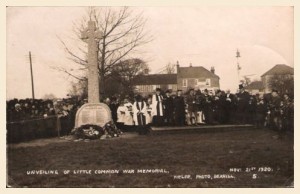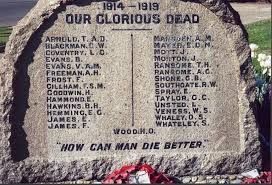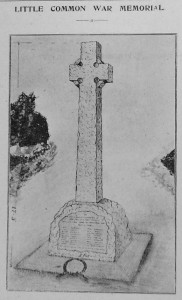 A War Memorial Committee was formed in 1919 to organise a memorial for the village of Little Common. A design was produced in late 1919 by Louis Frederick Roslyn, a well-known sculptor who after the war designed various memorials and became famous for his work, including the Bexhill Town War Memorial.
A War Memorial Committee was formed in 1919 to organise a memorial for the village of Little Common. A design was produced in late 1919 by Louis Frederick Roslyn, a well-known sculptor who after the war designed various memorials and became famous for his work, including the Bexhill Town War Memorial.
His design was approved by the Committee and the contract to produce, supply and erect the memorial was given to a stonemason in Eastbourne, R. Francis and Sons. There Roslyn carried out the main sculpture leaving the lettering and such to be completed by other stonemasons employed by the Company.
There’s an interesting story attached to the production of the memorial told by a descendent of William Bridgland, one of the stonemasons who carried out the carving of the lettering. William had joined the Army as a boy soldier and after the war had become a stonemason by trade and moved to Eastbourne to work for Francis & Sons. The story was told around the family that before the memorial was erected, probably in preparing the site, William hid one of his wife’s dresses so that the stone would be laid on it forever. Was it love that made him do that? Or was he using an old dress of his wife’s as a rag to wipe his brow and just threw it on the ground? No one in the family is sure which, if either, is true.
When the memorial was completed it was taken to the site at the green grassed area at the junction of Barnhorn Lane and Little Common Road and erected ready for the unveiling on 21st November. On one side of the memorial the following inscription reads: “1914 – 1918, Our Glorious Dead, (then the names of those who died), How Can Man Die Better”.
On the afternoon of Sunday the 21st of November 1920, the Mayor and the local council, the 231st Sussex Battery of the Royal Field Artillery, the Comrades of the Great War, many young pupils from several private schools, and a large number of local people, gathered in Little Common to unveil the new War Memorial – a Celtic Stone cross mounted on a rugged block of granite, with the names of the local men who had died in the First World War engraved at the base.
The dignitaries who attended included the Mayor (Ald J. Gibb), the Deputy-Mayor (Ald J. Rogers), the Town Clerk (Mr T. E. Rodgers), the Borough Surveyor (Mr George Ball), the Borough Accountant (Mr S. T. Hill), and Dr G. H. Weston (Medical Officer of Health). The schools that attended were the Caledonia and Effingham House Girls’ Schools and the boys’ schools Lake House, Seafield, and St Wilfrid’s School, Bexhill.
 Many ex-soldiers throughout Britain had formed organisations known as “The Comrades” (later to become with others, “The Royal British Legion”) and they marched together in the procession in remembrance of their fallen comrades. Major-General Sir John R. Longley, K.C.M.G., C.B., G.O., C., Home Counties Territorial Division, unveiled the Memorial and gave an address to all those assembled before the memorial.
Many ex-soldiers throughout Britain had formed organisations known as “The Comrades” (later to become with others, “The Royal British Legion”) and they marched together in the procession in remembrance of their fallen comrades. Major-General Sir John R. Longley, K.C.M.G., C.B., G.O., C., Home Counties Territorial Division, unveiled the Memorial and gave an address to all those assembled before the memorial.
Since the unveiling ceremony in 1920, the War Memorial Committee continues to meet and will continue to ensure that the Memorial is cared for and remains a focal point of the village. In 2012 at the request of his family, the Committee organised the addition to the memorial of the name of Private Robert Wood, who died in Afghanistan on 14 February 2011 and a ceremony was held there on 18th March 2012.

